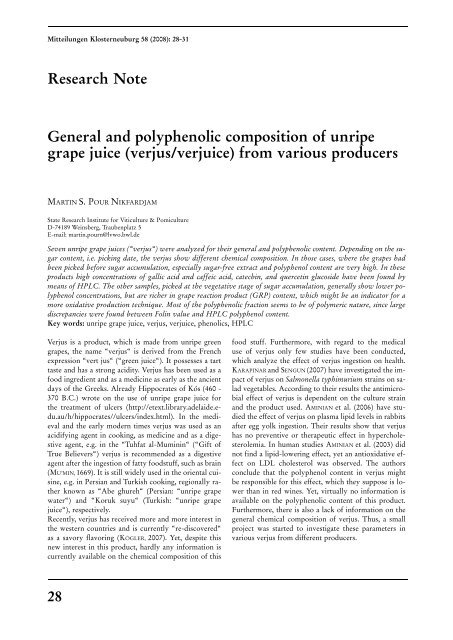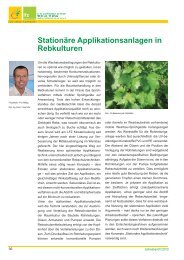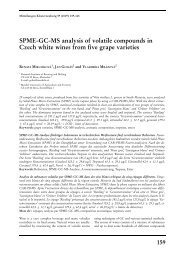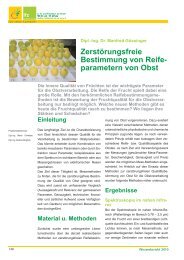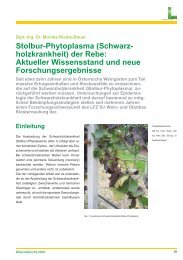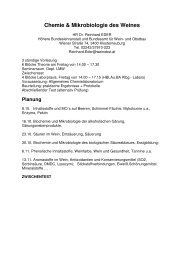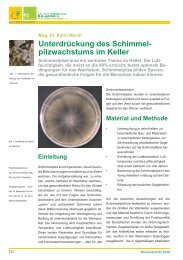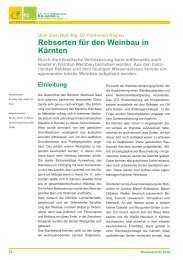General and polyphenolic composition of unripe grape juice (verjus ...
General and polyphenolic composition of unripe grape juice (verjus ...
General and polyphenolic composition of unripe grape juice (verjus ...
Create successful ePaper yourself
Turn your PDF publications into a flip-book with our unique Google optimized e-Paper software.
Mitteilungen Klosterneuburg 58 (2008): 28-31<br />
Research Note<br />
<strong>General</strong> <strong>and</strong> <strong>polyphenolic</strong> <strong>composition</strong> <strong>of</strong> <strong>unripe</strong><br />
<strong>grape</strong> <strong>juice</strong> (<strong>verjus</strong>/ver<strong>juice</strong>) from various producers<br />
MARTIN S. POUR NIKFARDJAM<br />
State Research Institute for Viticulture & Pomiculture<br />
D-74189 Weinsberg, Traubenplatz 5<br />
E-mail: martin.pourn@lvwo.bwl.de<br />
Seven <strong>unripe</strong> <strong>grape</strong> <strong>juice</strong>s (ª<strong>verjus</strong>ª) were analyzed for their general <strong>and</strong> <strong>polyphenolic</strong> content. Depending on the sugar<br />
content, i.e. picking date, the <strong>verjus</strong> show different chemical <strong>composition</strong>. In those cases, where the <strong>grape</strong>s had<br />
been picked before sugar accumulation, especially sugar-free extract <strong>and</strong> polyphenol content are very high. In these<br />
products high concentrations <strong>of</strong> gallic acid <strong>and</strong> caffeic acid, catechin, <strong>and</strong> quercetin glucoside have been found by<br />
means <strong>of</strong> HPLC. The other samples, picked at the vegetative stage <strong>of</strong> sugar accumulation, generally show lower polyphenol<br />
concentrations, but are richer in <strong>grape</strong> reaction product (GRP) content, which might be an indicator for a<br />
more oxidative production technique. Most <strong>of</strong> the <strong>polyphenolic</strong> fraction seems to be <strong>of</strong> polymeric nature, since large<br />
discrepancies were found between Folin value <strong>and</strong> HPLC polyphenol content.<br />
Key words: <strong>unripe</strong> <strong>grape</strong> <strong>juice</strong>, <strong>verjus</strong>, ver<strong>juice</strong>, phenolics, HPLC<br />
Verjus is a product, which is made from <strong>unripe</strong> green<br />
<strong>grape</strong>s, the name ª<strong>verjus</strong>ª is derived from the French<br />
expression ªvert jusª (ªgreen <strong>juice</strong>ª). It possesses a tart<br />
taste <strong>and</strong> has a strong acidity. Verjus has been used as a<br />
food ingredient <strong>and</strong> as a medicine as early as the ancient<br />
days <strong>of</strong> the Greeks. Already Hippocrates <strong>of</strong> KoÂs (460 -<br />
370 B.C.) wrote on the use <strong>of</strong> <strong>unripe</strong> <strong>grape</strong> <strong>juice</strong> for<br />
the treatment <strong>of</strong> ulcers (http://etext.library.adelaide.edu.au/h/hippocrates//ulcers/index.html).<br />
In the medieval<br />
<strong>and</strong> the early modern times <strong>verjus</strong> was used as an<br />
acidifying agent in cooking, as medicine <strong>and</strong> as a digestive<br />
agent, e.g. in the ªTuhfat al-Mumininª (ªGift <strong>of</strong><br />
True Believersª) <strong>verjus</strong> is recommended as a digestive<br />
agent after the ingestion <strong>of</strong> fatty foodstuff, such as brain<br />
(MU'MIN, 1669). It is still widely used in the oriental cuisine,<br />
e.g. in Persian <strong>and</strong> Turkish cooking, regionally rather<br />
known as ªAbe ghurehª (Persian: ª<strong>unripe</strong> <strong>grape</strong><br />
waterª) <strong>and</strong> ªKoruk suyuª (Turkish: ª<strong>unripe</strong> <strong>grape</strong><br />
<strong>juice</strong>ª), respectively.<br />
Recently, <strong>verjus</strong> has received more <strong>and</strong> more interest in<br />
the western countries <strong>and</strong> is currently ªre-discoveredª<br />
as a savory flavoring (KOÈ GLER, 2007). Yet, despite this<br />
new interest in this product, hardly any information is<br />
currently available on the chemical <strong>composition</strong> <strong>of</strong> this<br />
food stuff. Furthermore, with regard to the medical<br />
use <strong>of</strong> <strong>verjus</strong> only few studies have been conducted,<br />
which analyze the effect <strong>of</strong> <strong>verjus</strong> ingestion on health.<br />
KARAPINAR <strong>and</strong> SENGUN (2007) have investigated the impact<br />
<strong>of</strong> <strong>verjus</strong> on Salmonella typhimurium strains on salad<br />
vegetables. According to their results the antimicrobial<br />
effect <strong>of</strong> <strong>verjus</strong> is dependent on the culture strain<br />
<strong>and</strong> the product used. AMINIAN et al. (2006) have studied<br />
the effect <strong>of</strong> <strong>verjus</strong> on plasma lipid levels in rabbits<br />
after egg yolk ingestion. Their results show that <strong>verjus</strong><br />
has no preventive or therapeutic effect in hypercholesterolemia.<br />
In human studies AMINIAN et al. (2003) did<br />
not find a lipid-lowering effect, yet an antioxidative effect<br />
on LDL cholesterol was observed. The authors<br />
conclude that the polyphenol content in <strong>verjus</strong> might<br />
be responsible for this effect, which they suppose is lower<br />
than in red wines. Yet, virtually no information is<br />
available on the <strong>polyphenolic</strong> content <strong>of</strong> this product.<br />
Furthermore, there is also a lack <strong>of</strong> information on the<br />
general chemical <strong>composition</strong> <strong>of</strong> <strong>verjus</strong>. Thus, a small<br />
project was started to investigate these parameters in<br />
various <strong>verjus</strong> from different producers.<br />
28
Mitteilungen Klosterneuburg 58 (2008): 28-31<br />
Pour Nikfardjam<br />
Table 1: <strong>General</strong> chemical <strong>composition</strong> <strong>of</strong> the <strong>verjus</strong> samples (n.d. = not detected)<br />
Material <strong>and</strong> Methods<br />
Verjus samples<br />
The <strong>verjus</strong> samples were bought from different stores<br />
<strong>and</strong> from our own winery.<br />
<strong>General</strong> chemical parameters<br />
The general chemical parameters <strong>of</strong> wine <strong>composition</strong>,<br />
such as sugar, alcohol etc., were analyzed according to<br />
the <strong>of</strong>ficial methods <strong>of</strong> wine analysis (Commission Regulation<br />
(EC) No1293/2005 <strong>of</strong> 5 August 2005 amending<br />
Regulation (EEC) No2676/90 determining Community<br />
methods for the analysis <strong>of</strong> wines)<br />
Polyphenol content was measured using the Folin method<br />
as published by RITTER (1997).<br />
Color<br />
Color <strong>of</strong> unfiltered samples was measured in 10 mm<br />
plastic cuvettes by means <strong>of</strong> a Spectronic 1001 spectrophotometer<br />
(Milton Roy Company, Dreieich, Germany)<br />
at 420, 520 <strong>and</strong> 620nm.<br />
Chemicals<br />
All reagents used were <strong>of</strong> analytical grade unless otherwise<br />
stated. HPLC water, acetonitrile (gradient grade),<br />
<strong>and</strong> phosphoric acid were from Merck (Darmstadt,<br />
Germany).<br />
Polyphenol st<strong>and</strong>ards<br />
Gallic acid, tyrosol, catechin, epicatechin, procyanidin<br />
B 2 , p-coumaric acid, caffeic acid, ferulic acid, quercetin-3-rutinosid<br />
(rutin), trans-resveratrol, <strong>and</strong> quercetin<br />
were from Extrasynthese (Genay, France). Hydroxycinnamic<br />
acid esters were calculated as their respective<br />
free acids: caftaric acid, p-coutaric acid, fertaric acid,<br />
p-coumaroyl-glucosyl-tartrate (p-CGT), <strong>and</strong> Grape<br />
Reaction Product (GRP, 2-S-glutathionyl caffeoyl tartaric<br />
acid). Hydroxycinnamic acid esters were identified<br />
by their photodiode array (PDA) spectra <strong>and</strong> retention<br />
time.<br />
Equipment<br />
A Dionex (Germering, Germany) UltiMate 3,000<br />
HPLC system consisting <strong>of</strong> degasser, autosampler,<br />
pump, column oven, <strong>and</strong> photodiode array (PDA) detector<br />
was used. Best selectivity by means <strong>of</strong> a PDA detector<br />
was achieved at 280nm for benzoic acids; at<br />
310nm for trans-resveratrol; at 320nm for hydroxycinnamic<br />
acids <strong>and</strong> their respective esters <strong>and</strong> GRP; <strong>and</strong><br />
at 360nm for flavonols.<br />
HPLC method<br />
Separation <strong>of</strong> the <strong>polyphenolic</strong>s was performed using<br />
the method published by RECHNER et al. (1998).<br />
Sample preparation<br />
Before analysis by HPLC, all samples <strong>and</strong> st<strong>and</strong>ards<br />
were filtered through a Sartorius (GoÈ ttingen, Germany)<br />
Minisart RC 15 1 0.45mm filter. A volume <strong>of</strong> 20ml was<br />
injected.<br />
29
Mitteilungen Klosterneuburg 58 (2008): 28-31<br />
Pour Nikfardjam<br />
Statistics<br />
All statistical analyses were performed using Excel 1<br />
(Micros<strong>of</strong>t Corp., Redmond, USA) <strong>and</strong> XLSTAT 1<br />
(Addins<strong>of</strong>t SARL, Paris, France).<br />
Table 2: Polyphenolic <strong>composition</strong> (mg/l) <strong>of</strong> the analyzed<br />
<strong>verjus</strong> samples (F = France, G = Germany, IR = Iran;<br />
results are mean values <strong>of</strong> two independent injections;<br />
n.d. = not detected)<br />
Results <strong>and</strong> Discussion<br />
<strong>General</strong> chemical <strong>composition</strong><br />
The general chemical <strong>composition</strong> <strong>of</strong> the <strong>verjus</strong> samples<br />
is given in Table 1. As can be seen those samples having<br />
low to no sugar content show also high contents in total<br />
acidity, sugar-free extract, <strong>and</strong> polyphenol content.<br />
Presumably, these samples were made from <strong>grape</strong>s before<br />
sugar accumulation started or when sugar concentration<br />
was still very low. Thus, their content on acidity<br />
<strong>and</strong> polyphenols is much higher. It is well known from<br />
literature that the polyphenol content <strong>of</strong> <strong>grape</strong>s reaches<br />
two maxima during ripening: one at or shortly after<br />
veÂraison <strong>and</strong> the other at maturity (FERNANDEZ DE SI-<br />
MON et al., 1992). Some <strong>of</strong> the samples show polyphenol<br />
contents higher than 780mg/l. Thus, the presumption<br />
made by AMINIAN et al. (2003) that <strong>verjus</strong> could also<br />
provide high polyphenol concentrations can be confirmed.<br />
The samples from Iran also show only very low<br />
alcohol contents, which supports the thesis that these<br />
products were made from <strong>grape</strong>s picked at low sugar<br />
levels. Yet, these products showed high contents on volatile<br />
acidity, which was also noted during sensory evaluation<br />
(data not shown). Presumably, these products<br />
either had low sugar or alcohol contents, respectively,<br />
<strong>and</strong> experienced a slight microbial spoilage during production.<br />
Polyphenolic pr<strong>of</strong>ile (HPLC)<br />
With regard to <strong>polyphenolic</strong> <strong>composition</strong> also large differences<br />
were found between the samples. Especially in<br />
those samples with low sugar content high concentrations<br />
on gallic <strong>and</strong> caffeic acid, catechin, <strong>and</strong> quercetin<br />
glucoside were found. These higher contents are also<br />
probably due to the earlier ripeness stage, at which the<br />
<strong>grape</strong>s were picked.<br />
The samples from Germany showed higher contents on<br />
GRP, while the other samples were practically GRPfree.<br />
This might be an indicator for the more oxidative<br />
production technique in Germany compared to the<br />
samples from Iran <strong>and</strong> France, since GRP is formed under<br />
oxidative conditions from caftaric acid <strong>and</strong> glutathione<br />
(CHEYNIER et al., 1990).<br />
The total polyphenol content as estimated by HPLC<br />
ranges from 43 to 156mg/l. Therefore, in some cases<br />
the Folin value is about 8.5-fold higher than the total<br />
polyphenol amount measured by means <strong>of</strong> HPLC.<br />
This leads to the supposition that most <strong>of</strong> the <strong>polyphenolic</strong><br />
fraction within <strong>verjus</strong> is <strong>of</strong> polymeric nature <strong>and</strong>,<br />
thus, is not detected during monomeric polyphenol<br />
analysis by HPLC. Since polymeric phenols are wellknown<br />
for their astringent <strong>and</strong> bitter taste (VIDAL et<br />
al., 2003), this would also explain the sensory characteristics<br />
generally associated with <strong>verjus</strong>.<br />
Conclusion<br />
Verjus samples were analyzed on their general chemical<br />
<strong>composition</strong> as well as their <strong>polyphenolic</strong> fingerprint.<br />
The results show that the <strong>verjus</strong> samples contained different<br />
concentrations <strong>of</strong> acidity, sugar-free extract, <strong>and</strong><br />
total polyphenols as determined by means <strong>of</strong> the Folin-Ciocalteu<br />
method. Early harvested samples generally<br />
contained much higher contents in gallic acid <strong>and</strong><br />
caffeic acid, catechin, <strong>and</strong> quercetin glucoside, while later<br />
harvested samples showed lower polyphenol concentrations,<br />
but were richer in GRP content, which<br />
might be an indicator for a more oxidative production<br />
technique. Most <strong>of</strong> the <strong>polyphenolic</strong> fraction <strong>of</strong> <strong>verjus</strong><br />
seemed to be <strong>of</strong> polymeric nature, since large discrepancies<br />
were found between Folin value <strong>and</strong> HPLC<br />
polyphenol content. More detailed studies are neces-<br />
30
Mitteilungen Klosterneuburg 58 (2008): 28-31<br />
Pour Nikfardjam<br />
sary to investigate the influence <strong>of</strong> cultivar <strong>and</strong> ripeness<br />
stage on <strong>composition</strong> <strong>and</strong> sensory quality <strong>of</strong> this interesting<br />
product.<br />
References<br />
Aminian, B., Massompour, S.M., Sadeghalvad, A. <strong>and</strong> Omrani,<br />
G.H. 2003: Unripe <strong>grape</strong> <strong>juice</strong> (ver<strong>juice</strong>) as a lipid-lowering<br />
agent: fact or fiction. Arch. Iran Med. 6: 32-34<br />
AMINIAN, A., AMINIAN, B., NEKOOIAN, A.A. <strong>and</strong> HOSEINALI, F.<br />
2006: Effect <strong>of</strong> <strong>unripe</strong> <strong>grape</strong> <strong>juice</strong> (ver<strong>juice</strong>) on plasma lipid<br />
levels in rabbits rendered Hypercholesterolemic by<br />
feeding egg yolk. Acta Med. Iranica 44: 230-234<br />
KOÈ GLER, F. 2007: Weingeschichten. Dt. Weinbau 8: 13.<br />
CHEYNIER, V., RIGAUD, J. <strong>and</strong> MOUTOUNET, M. 1990: Oxidation<br />
kinetics <strong>of</strong> trans-caffeoyltartrate <strong>and</strong> its glutathione derivatives<br />
in <strong>grape</strong> musts. Phytochem. 29: 1751-1753<br />
FERNANDEZ DE SIMON, B., HERNANDEZ, T. <strong>and</strong> ESTRELLA, I. 1992:<br />
Relationship between chemical structure <strong>and</strong> biosynthesis<br />
<strong>and</strong> accumulation <strong>of</strong> certain phenolic compounds in<br />
<strong>grape</strong> skins during ripening. Z. Lebensm.-Unters. Forsch.<br />
195: 124-128<br />
KARAPINAR, M. <strong>and</strong> SENGUN, I.Y. 2007: Antimicrobial effect <strong>of</strong><br />
koruk (<strong>unripe</strong> <strong>grape</strong>-Vitis vinifera) <strong>juice</strong> against Salmonella<br />
typhimurium on salad vegetables. Food Control<br />
18: 702-706<br />
MU'MIN, S.M.M. (1669) In: Tuhfat al-Muminin, quoted in: Farid<br />
Alakbarli: Medical Manuscripts <strong>of</strong> Azerbaijan. -<br />
Baku (Azerbaijan): HAF, 2006<br />
RECHNER, A., PATZ, C.D. und DIETRICH, H. 1998: Polyphenolanalytik<br />
von FruchtsaÈften und Weinen mittels<br />
HPLC7UV/ECD an einer fluorierten RP-Phase. Dt. Lebensm.<br />
Rundsch. 94: 363-365<br />
RITTER, G. 1997: Die Bedeutung der phenolischen Saft- und<br />
Weininhaltsst<strong>of</strong>fe waÈhrend der Verarbeitung von aÂpfeln,<br />
Speierling und weiûen Trauben - Der Einfluû moderner<br />
Verfahrenstechnologie auf die QualitaÈt des Endproduktes.<br />
Gesellschaft zur Fªrderung der Forschungsanstalt,<br />
Geisenheim/Germany<br />
VIDAL, S., FRANCIS, L., GUYOT, S., MARNET, N., KWIATKOWSKI,<br />
M., GAWEL, R., CHEYNIER, V. <strong>and</strong> WATERS, E.J. 2003: The<br />
mouth-feel properties <strong>of</strong> <strong>grape</strong> <strong>and</strong> apple proanthocyanidins<br />
in a wine-like medium. J. Sci. Food Agric. 83(6):<br />
564-573<br />
Received June 29, 2007<br />
31


